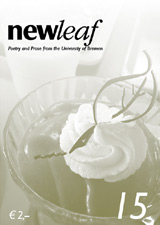editorial

Of other books
'Often books speak of other books. Often a harmless book is like a seed which will blossom into a dangerous book, or it is the other way around: it is the sweet fruit of a bitter stem. In reading Albert, couldn't I have learned what Thomas might have said? Or in reading Thomas, know what Averroes said?' 'True' I said amazed. Until then, I had thought each book spoke of things, human or divine, that lie outside books. Now I realised that not infrequently books speak of books: it is as if they spoke among themselves.
This little passage from Umberto Eco's The Name of the Rose has been bandied about among narrat- and other breeds of ologists in the twenty-odd years since the Italian semiologist-turned-novelist published his best-seller. Unlike the young Adso, though, we should certainly not be amazed at Brother William's revelation - we who, after all, know that most of Shakespeare's oeuvre was nothing else but a huge 're-write' project. Renaissance post-modernism indeed.
As the opening quotation suggests, we have a solid thematic focus in this newleaf, in which our authors have responded to texts already written. Intertextuality: there, we've said it. That was the flogged-to-death trendy buzzword we were trying to avoid by using Eco's dialogue. We won't say it again, we promise. Apart from that subconscious reference to what-has-already-been-written which resonates in every text in every culture, there are various ways in which the author can dance with the canon. The most common forms are parody and homage, and the two most common approaches are via the form and the spirit of the reference text. Jana Mewis, for instance, has taken the seed of loneliness in Rilke's panther poem and applied it to a human being. Julia Boll, too, has adopted the form - almost syllable for syllable - of Pavel Kohout's poem and filled it with related emotions in a different setting. Kirsten Steppat's Pearl Earring poem adds a third dimension, for it echoes Tracy Chevalier's novel based on Vermeer's portrait. From 'the film of the book', Steppat has shifted to the poem of the book of the painting. In turn, Natalie Schulz' text is a response to a film - Marcus Behrens' experimental television dance film Rugas. Kendra Shirley has put new lyrics to a song. And some of the texts interrelate with each other: spot the flowers and the two sestinas.
Unfortunately we have not been able to reproduce all the texts that our authors have based theirs on. Copyright laws are strict, writers can be slow to react to requests, and agents and publishers are sometimes tempted to earn a few bucks more. So special thanks to Ian McMillan and Adrian Mealing for giving us permission to publish 'Cautionary Tale for Rhyming Poets' in full without a fee. Ian McMillan is one of Britain's best-known poets, performers and broadcasters (he hosts The Verb on the BBC) and is currently writer-in-residence at both Humberside Police and Barnsley FC (a job which took him into the Premiership for one heady season but has now left him stranded near the bottom of the First Division). His latest book is Perfect Catch (Carcanet Press). We hope to invite him to Bremen some time soon. Whereas the typical Ole Herlyn story is very much an enclosed space, the open-ended the nature of 'Au pair' might surprise those who know her work. It reads very much like the beginning of something much longer. Well - maybe it is...
In addition to fifteen issues of the magazine and the five books in the newleaf Press series, we have also recently produced two 'special numbers' containing individual short stories as gifts for those buying newleaf on campus: Daniela Bermond's 'Somewhere under the Sun' was published in two parts in Summer 2002 and Ole D. Herlyn's 'Vereinsamt' at Christmas 2002. We have decided to offer them to a broader readership and so they are now - or will be very soon - available on our website. Enjoy. Both these pamphlets were produced and edited by Julia Boll, who is also in the process of putting together a book of poems and short prose by Ole. We are currently on the lookout for a special sponsor for this great project (volunteer, anyone?) and hope that the book will be on sale this year. Watch this space. All the illustrations this time are by our own 'house' graphics editor, Oliver Chrystossek, who of course has produced a super cover - as always. Thanks, Olli.
Simon Makhali and Ian Watson, June 2003
contents
-
The Princess and the Rogue
-
But no Elephants
-
Metamorphoses
-
‘a musical journey’
the fourth
-
All Four at Once
Au pair
-
Stealing
-
The End of That
-
Cautionary Tale for Rhyming Poets
-
The Lonely Man
-
White-out
L'arrache-coeur
-
Enlightened
-
John's Write
Citty Kat!
-
Girl with a Pearl Earring
Assurance
-
Nightmare
Contango
-
A Mother's Watch
Early Start
Church, 2000
-
Dirt Tracks Drowning
-
It's in the Photograph
Aftermath
City of Glass
